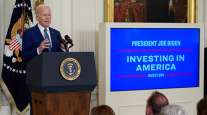Tapping Private Sector for Roads, Bridges Poses Hurdles for Trump

One alternative asset manager raised $14 billion for infrastructure deals last year — the biggest such fund ever. About six months later, another manager topped it, raising $15.8 billion.
Soon, both those funds could be dwarfed if Blackstone Group, the world’s largest private-equity firm, gets back into the game. Joe Baratta, the firm’s global head of private equity, told Bloomberg Television it might raise as much as $40 billion for infrastructure deals.
But even as President Trump vows to steer more private money toward improving U.S. roads, bridges and airports, familiar impediments may hinder investors.
“The issue here isn’t availability of capital,’’ said Sam Pollock, CEO of Brookfield Asset Management Inc.’s infrastructure group, which raised the $14 billion fund last year. “It’s whether or not you can truly make projects, as they say, ‘shovel ready.’ ”
Trump has vowed to refurbish U.S. infrastructure by investing as much as $1 trillion over 10 years and putting millions of people to work. The president hasn’t provided details, but he has proposed drawing on private capital in what Elaine Chao, his new Transportation secretary, has called a “bold new vision.”
Fund executives say they hope for more U.S. investment opportunities. But problems that dogged former President Barack Obama’s attempt to jump-start infrastructure spending haven’t vanished: Lengthy planning and permitting processes limit the projects that are ready for investment, fund managers say. Also, many lack a ready stream of revenue, such as tolls, to make them work as investments.
At the same time, there’s little existing framework for deals with states and municipalities, which own much of the infrastructure and approve projects. Only 38 states, the District of Columbia and Puerto Rico have enacted legislation facilitating public-private partnerships for some infrastructure projects, according to the National Conference of State Legislatures.
That means the federal government needs to step in with incentives for governments to work with the private sector and for arrangements such as “asset recycling,” in which a public facility is privatized and the proceeds are used for other projects that lack funding, said Tom Osborne, executive director at IFM Investors in New York.
“There is a tremendous amount of capital sitting on the sidelines today that would be willing to invest in equity for public-private partnerships if there was a willingness by the state and local governments to explore it,’’ Osborne said Jan. 25.
Fund managers say they’re encouraged by the president’s promise to reduce regulatory delays and that both major parties are talking about making infrastructure a priority. Still, they want details.
A report last year by the American Society of Civil Engineers, which advocates for increased infrastructure spending, found a $1.4 trillion funding gap through 2025 in 10 areas including aviation, electricity, bridges, roads and drinking water. The number is $3.6 trillion through 2020 when dams, hazardous waste, levees, parks, schools and solid waste are included.
The National Governors Association surveyed states for examples of priority projects that were “on the path to shovel ready” with at least 30 % of initial design and engineering work done. It submitted a list of 428 projects from 49 states and territories to the Trump administration this month.
Democrats and some Republicans in Congress are pushing for more direct federal spending, arguing that private investment alone won’t meet U.S. needs. But congressional Republican leaders have said they expect any plan to rely heavily on private funds, and administration officials have floated the idea of using a tax credit, as well as tax proceeds from returning an estimated $2.6 trillion in corporate profits kept overseas.
Even before Trump’s election, infrastructure investment worldwide had been growing for several years, reaching a record $413 billion in 2016, according to data provider Preqin. Global Infrastructure Partners, an owner of London’s Gatwick Airport, announced last month it raised a record $15.8 billion for the largest fund of its kind — almost double its previous pool in 2012.
“The next phase is to make the case for much greater private involvement,’’ GIP Chairman Adebayo Ogunlesi said in an interview. “There’s a tremendous wall of capital that wants to invest in infrastructure.’’
As of January, unlisted infrastructure funds had $148 billion in “dry powder,’’ or funds not yet invested — almost half of it from North America, according to Preqin.
Graeme Conway, head of Macquarie Infrastructure and Real Assets in the Americas, said it remains to be seen how good Trump’s initiative will be for private investors.
“From our perspective, the discussion is good, the intent is good,’’ Conway said. “The open question is, ‘Where does all of this likely go?’ ’’
Sen. John Barrasso (R-Wyo.), chairman of the panel on environment and public works, has highlighted the difficulty of attracting investors to rural projects, which lack population density and the ability to generate enough revenue to make an investment worthwhile.
Some investors say the United States needs to allow for privatizing more infrastructure to generate funds for other projects. That approach, called asset recycling, has been done in Australia — a lease of power distributor Ausgrid last year was sold for A$16.2 billion ($12.4 billion), and some of that money has been earmarked for new schools, hospitals and public transit.
But asset recycling has detractors. Canada’s largest union for public employees has warned the employees could see wages cut. In the United States, some cities and states have balked at the prospect of losing public control of infrastructure.
“I’m hopeful,” Brookfield’s Pollock said when asked whether he thinks Trump’s presidency will bring more investment opportunities in infrastructure. “I can’t say I’m optimistic; I’m hopeful.’’




